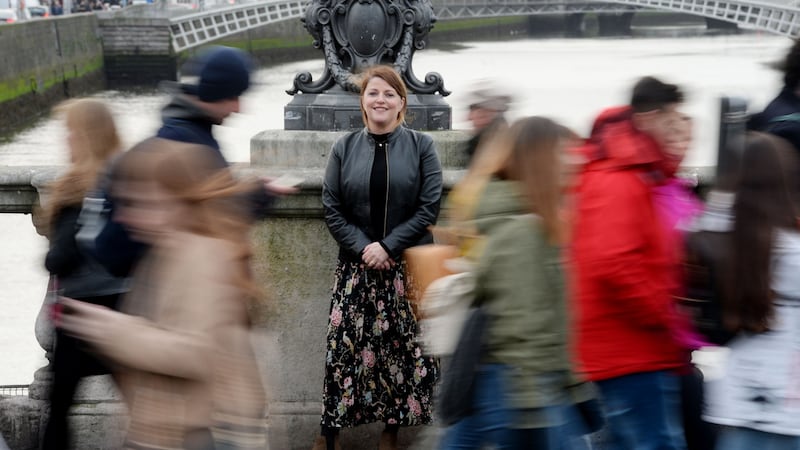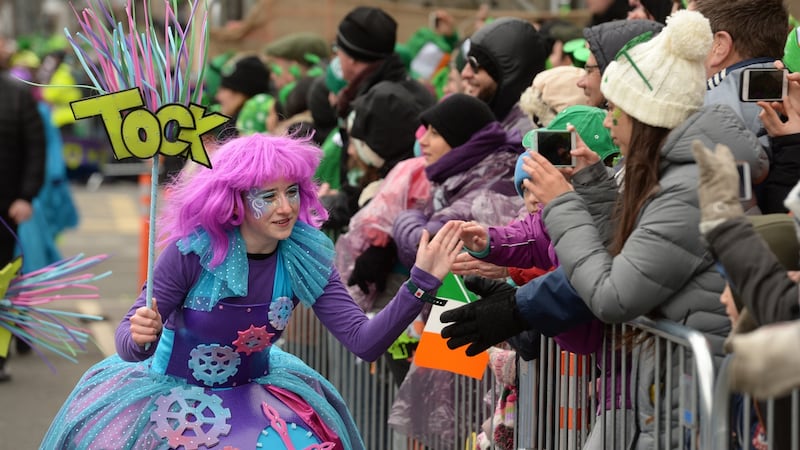Once upon a time, long, long ago, there was St Patrick’s Day parade. (Even longer and longer ago, there was St Patrick himself, of course – or rather, two St Patricks, but let’s not get into that now). And, unless you were in America, those parades might have had a few lorry floats, a scattering of scouts or guides, and a clown with a balloon. (This is an exaggeration. Plus, sometimes an American marching band enlivened proceedings.)
Somewhere along the way there came some awareness this was a missed opportunity, and we could do much better.
Thus was born, in Dublin way back in 1996, the St Patrick’s Festival. It has grown over nearly 25 years into an ever more elaborate festival, when “Ireland welcomes the world”. These days it’s a four- or five-day multidisciplinary arts festival and civic celebration, with a global audience. Circling around the now very impressive parade is an extensive programme, including other free events. Lots for the citizen and lots for the visitor.
The St Patrick’s Festival has also done the business – and the organisers say they can quantify the economic impact of this “incomparable global expression of Ireland”: a €73 million return to the economy (€22 million of it outside Dublin), representing a 52:1 return on €1.4 million state investment. Some 105,000 people visit from abroad (28 per cent of them return trips).
Big Day Out
Now the festival involves more than 40 events across five days – including a Big Day Out in Merrion Square, this year expanded to a three-day Festival Village with science shows, music, street theatre, food and a céilí mór.
All this is put together by a team, led by CEO Susan Kirby, of six through the year, expanding to 30 or 40 for the final months, and countless thousands' involvement come festival time. The result is what they call "an enduring, priceless national asset and the largest, most accessible celebration of contemporary Irish culture and rich Irish heritage globally".
On Tuesday night, as details of this year’s St Patrick’s Festival are announced, Kirby will outline the board’s vision for the future: to expand the five-day festival celebrating our national day into a month-long event. Paddy’s mere Day is no more; let’s call it Paddy’s March (of expansion).

What's proposed is a countrywide celebration around a theme through the month of March each year. The plan to be unveiled includes: opening and closing ceremonies; themed programmes from the National Cultural Institutions; a week-long festival village; a year-round creative learning and access programme connecting artists and communities; a celebration of Irish culture, food and sport; a bands spectacle in Dublin Castle; Beo ("an awakening of Irish language"); a curated cultural programme across the country inspired by Culture Night; an annual commission; We Are Ireland, an international programme and diplomacy involving agencies such as Culture Ireland, Global Ireland and Tourism Ireland.
There’s also talk of a symposium, EIRU, tendering a “vision for Ireland”, inviting “thinkers, shapers, boundary breakers and diaspora”. And, of course, marketing, along the lines of “Ireland welcomes the world”.
It’s ambitious (if heavy on the vision-speak and still unspecific): a plan for an “inclusive, bold programme” to celebrate “our cultural wealth and diversity” and including “extraordinary works of parade pageantry and visceral spectacles that affect audiences emotionally internationally and inspire national pride at home. A programme that considers our identity and place in a global context and which reclaims public spaces for people at home.” Could something like this really happen?
Guff and buzzwordery
There’s a certain level of guff and buzzwordery surrounding all this – talk of strategic alliances, partnerships with intent, learnings to be had, wider beneficiary audiences and broad stakeholder bases.
But cutting through that, it also seems, when Kirby talks about it with enthusiasm, that some of it is already exists, or the “strategic alliances” behind it do, and it sounds like the plan includes co-ordinating and expand things that are there already, in silos.
The festival's "agencies and audiences and stakeholder base is so broad. It's the sum of its parts", says Kirby. Its various tentacles stretch into a range of departments and agencies: Transport & Tourism, and Culture, Heritage and the Gaeltacht; but also Fáilte Ireland and Tourism Ireland, as well as Dublin City Council. They are all, along with RTÉ, the Arts Council, Dublin Chamber of Commerce and others from media, business, finance and law, represented on the 12-strong board, led by chairwoman Judy Woodworth.
Their plan is to stretch all those tentacles into a month-long Irish shindig, across Ireland and abroad. They don’t envisage a parade every weekend or anything daft, but it seems to be more about curating events through March, with some big anchors, such as the symposium (at the beginning of the month, before the politicians’ exodus).

Kirby describes it as a “statement of intent”: it is the board’s vision for how to move forward and capitalise on what it sees as an opportunity. The conversation has started, she says, with Government departments and other partners. There is support and interest, but it has a way to go yet, not least regarding how to fund it (the current festival budget is €1.9 million).
The strategy, an expansion of the festival’s existing strategy, stretches for 10 years from 2020. The next stage, says Kirby, is to make the business case. Plus, the Department of Transport and Tourism is reviewing the festival (with an internal report around the end of April) and Kirby expects scoping this proposal to form part of that.
London Olympics
The festival has been inspired by initiatives ranging from Imagining Ireland to Farmleigh, and others such as the volunteer programme at the London Olympics. The Culture Night model across Ireland is also referenced, but Kirby sees what they might do as a hybrid, curated version, around the festival’s annual theme, creating “a spring celebration of our culture”. There has been criticism that in some cases artists are not paid for their work on Culture Night. Kirby says: “We are a professional festival. We pay artists.”
This statement of intent about a Paddy’s March also begs the question: why would we want to do something like this?
Says Kirby, “because through strategic partnership we can amplify even further the positive share of voice that Ireland has”. That is, our share of voice globally.
With an expansion “we can deliver even more on our remit for tourism and in terms of our citizens and social impact.”
St Patrick’s Day is, says Kirby, “in an unusual situation, as probably one of the most well-known national holidays in the world, and I feel passionately that we should be leaders in what a national cultural celebration should be. It’s defining that, and having the conversation about what that might look like.”
The greatest reward would be in terms of active citizenship and participation in the arts, and standing really proud over the time of our festival
But who is it all for? Both Irish people and visitors. “The primary audience is the citizen, and the wider beneficiary audiences are business, and the Government, and being able to look at how we can best capitalise on the festival. I am a fan of people coming together to do exceptional things in the city, and what that gives us.” She is enthusiastic about “the community and artistic effort that goes into producing the parade” every year (which then has a knock-on effect for other parades outside the capital). The festival spends about six months annually preparing for that, partnering community groups and pageant companies to create sections of the parade. “I’ve seen such gorgeous responses when we get the opportunity to engage with people for the parade and festival.”
Kirby would like to extend this into a year-long community programme. She sees this as part of being part of a cultural hub in the city, a proposal for which there is widespread demand from creatives and arts organisations.
“The greatest reward,” says Kirby, “would be in terms of active citizenship and participation in the arts, and standing really proud over the time of our festival. And then all the benefits from that – tourism, economic, the opportunity to invite people in [to Ireland] during the month of March.”









